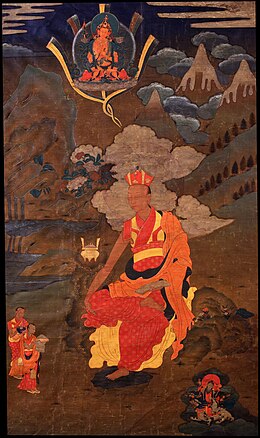Khachö Wangpo
Khachö Wangpo (1350 – 1er septembre 1405[1]) est Le deuxième shamarpa, un lama de l'école Karma Kagyu du bouddhisme tibétain.
| Shamar Rinpoché |
|---|
| Naissance | |
|---|---|
| Décès | |
| Activités | |
| Mère |
Drokmo (d) |
| Maîtres |
Tertön Sangye Lingpa (d), Ya Zangpa Sönam Ö (d), Rolpe Dorje |
|---|
Biographie
modifierKhachö Wangpo reconnu par Rolpe Dorje, le 4e karmapa, comme la deuxième incarnation de Khaydrup Dragpa Senge, le premier shamarpa[2]. Il est né à Chema-lung Namshung, au nord du Tibet, l'année du Tigre. Déjà dans sa jeunesse, il a eu de nombreuses visions spontanées. À l'âge de sept ans, il rencontre le 4e karmapa, devant lequel il prononce les vœux d'upasaka et de bodhisattva. Il reçut également de lui la transmission de la Voie du Diamant (vajrayana), du mahamudra, des six yogas de Naropa et la transmission orale de la lignée Kagyu. Il a également étudié les sutras et les tantras avec de nombreux grands maîtres Kagyu et Nyingma[2]. Le 4e karmapa lui remit la Couronne Rouge Rubis cérémoniale, et après sa mort, Khachö Wangpo devint le détenteur de la lignée et poursuivit son activité jusqu'à l'intronisation de Deshin Shekpa comme 5e karmapa. Khachö Wangpo a été l’un des premiers enseignants à consigner sur papier certains de ses enseignements clés. Toutes ses œuvres sont contenues dans un total de 8 volumes[2]. La moitié seulement nous est parvenue[3]. Il est décédé à l'âge de 55 ans, selon l'astrologie tibétaine, l'année du Coq de Bois, accompagné de nombreux signes de réalisation spirituelle[2]. Parmi les nombreux disciples, le plus important était Sokwon Rikpe Raldri, qui devint plus tard le principal enseignant du 6e karmapa Thongwa Dhonden. Il a également transmis tous les enseignements Kagyu au 5e karmapa[2].
Un thangka décrit l'expédition de Kachö Wangpo vers un groupe de huit montagnes, Namlha Gye Kang Gi Rawa, accompagné de deux étudiants. Au pied des montagnes, Kachö Wangpo effectue une offrande de « khandro chitor » suivie d'un rituel d'offrande de fumée « sang ». Il compose alors spontanément une nouvelle liturgie d'offrande - encore utilisée aujourd'hui. Tseringma, une des « cinq sœurs de longue vie » (tibétain : ཚེ་རིང་མཆེད་ལྔ, Wylie : tshe ring mched lnga, THL : Tsering Chenga), déesse de la montagne et protectrice du bouddhisme liée à la tradition karma-kagyu, fut satisfaite de l'offrande et apparut aux trois lamas[4].
Texte sur la vie de Milarépa
modifierKhachö Wangpo a notamment écrit Clouds of Blessings (Nuages de bénédictions), un récit de la vie de Milarépa. Une comparaison avec ‘’A River of Blessings’’ montre qu’il existe des passages similaires à Clouds of Blessings, mais suggère que Clouds of Blessings est un texte antérieur. La version de Tsangnyön Heruka est proche de Clouds of Blessings, mais l'élargit considérablement. Shamarpa s’est basé vraisemblablement sur des passages du texte de Donmo Ripa, soit directement à partir de ce texte, soit en utilisant The Dark Treasury comme intermédiaire[5].
Notes et références
modifier- (en) Nik Douglas, Meryl White, Karmapa: The Black Hat Lama of Tibet, 1976, p. 143-144 : « The second Shamar Tulku, KHA CHOD WANGPO, was born in the Tibetan male iron tiger year (1350) at Chema Lung in Chang Namshung, Northern Tibet. At the age of seven months Karmapa Rolpe Dorje appeared before him in a vision and said: "The flower is ready, but not yet opened, Wait for the right time, for you are still human. Highly qualified as you are, please wait a little longer, And I shall teach you to become fully perfected!" Then Karmapa snapped his fingers in the air and from that moment the young child could remember all the details of his past life and began to tell people that he was the incarnation of Trakpa Senge. By the age of fourteen months he was preaching the Dharma and at the age of three years was giving specific teachings. His fame spread quickly, reaching servants and disciples of the previous Shamar Tulku. They came to visit him and immediately recognised him as the new incarnation. Then he was taken to Kampo Nesnang monastery, where he was enthroned. At the age of seven years, while crossing a river, he met Karmapa Rolpe Dorje, who taught him the complete Mahamudra, the Six Yogas and the Kargyudpa Lineage. From Khenpo Dondrup Pal he received the primary and secondary ordinations. Having completed his studies he travelled to the pilgrimage-place of Tsari, where he had an auspicious vision of the Siddha Dombhi Heruka. Later he received a Red Hat (Tib: Zha-mar) from the Gyalwa Karmapa in recognition of his great achievements and as a symbol of his function as a teacher. Shamar Kha Chod Wangpo recognised the next incarnation of Karmapa, Debzhin Shegpa, and enthroned him at the Tsurphu monastery where he transmitted the teachings to him. At the age of thirty-seven he founded a large monastic meditation centre at Gaden Mamo and soon there were three hundred Yogis practising there. He engaged himself in the perfection of the secret teachings and had many visions of Protectors and Tutelary Deities, from whom he received many important initiations. On the twenty-ninth day of the seventh month of the female wood bird year (1405) he passed away. His foremost disciples were the fifth Karmapa, Lama Kazhipa Rinchen and Sowon Rigpe Raldre. »
- (en) Tenzin Gyurme, The Golden Rosary, , 108 p. (ISBN 9780557435647, lire en ligne), p. 49.
- (en) Martina Draszczyk, Direct Introductions into the Three Embodiments, Supreme KeyInstructions of the Dwags po Bka’ brgyud Tradition, Revue d'études tibétaines, no. 45 Avril 2018, pp. 145-177.
- https://www.himalayanart.org/items/961
- (en) Peter Alan Roberts, The Biographies of Rechungpa : The Evolution of a Tibetan Hagiography, , 304 p. (ISBN 9781135989125, lire en ligne), p. 26.
- (pl) Cet article est partiellement ou en totalité issu de l’article de Wikipédia en polonais intitulé « Kacio Łangpo » (voir la liste des auteurs).
Liens externes
modifier
